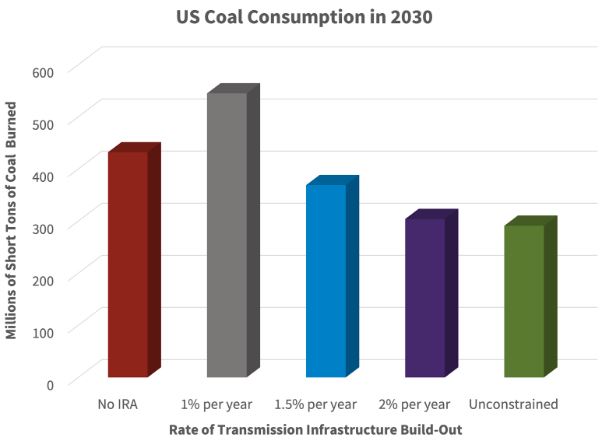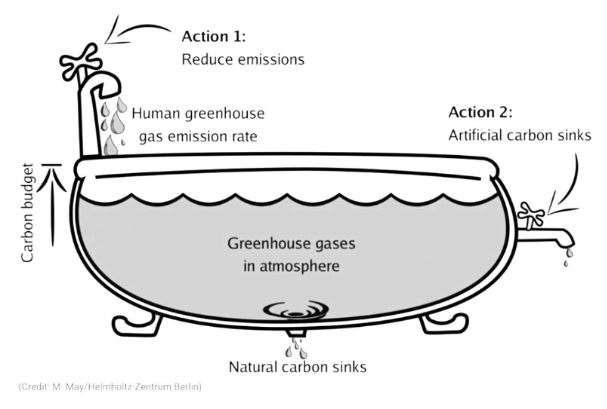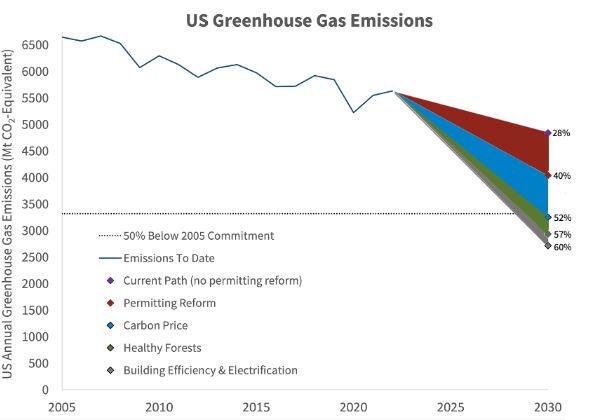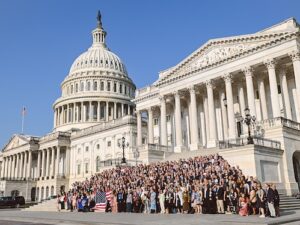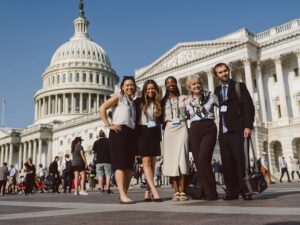 Rolling out CCL’s 2023 Policy Agenda at the December 2022 conference
Rolling out CCL’s 2023 Policy Agenda at the December 2022 conference
By Dana Nuccitelli
At the fall conference on December 3rd, I had the privilege of explaining the scientific underpinning of CCL’s policy agenda heading into 2023 to the 1,200 CCL volunteers in attendance. Our agenda consists of four policy areas that can help build on the major climate policy success achieved by the passage of the Inflation Reduction Act (IRA).
We’re confident that CCL has grown to the point where we can now effectively advocate for multiple important climate solutions. Our criteria for these policy areas were that they should be effective at reducing net greenhouse gas emissions and they should facilitate building bridges with Congress and in our communities.
Carbon Pricing
Putting a price on carbon pollution and providing carbon cashback to Americans will, of course, remain a central component of CCL’s policy agenda. Carbon pricing is the single most effective climate policy when it comes to reducing climate pollution, and returning the revenue to households via dividend checks has the added benefits of reducing income inequality and alleviating poverty. For example, a study from last year found that a carbon fee and dividend policy could raise 1.6 million Americans above the poverty line.
We’ll probably talk about carbon border adjustment mechanisms more in 2023 as well, due to their bipartisan appeal. This is when a price is applied to the extra carbon content in a high-carbon intensity material or product when it’s imported across the U.S. border from another country. It levels the playing field for American industries that are already relatively clean and low-carbon so that dirtier competition from abroad doesn’t have an economic advantage.
For more information, see our new carbon pricing page on Community which includes an intermediate training page, as well as a recording of the great conference breakout session on this topic.
Clean Energy Permitting Reform
While energy modeling groups estimated that the IRA could help reduce U.S. carbon pollution by 40% below 2005 levels by 2030, subsequent analysis found that slow clean energy infrastructure permitting could act as a bottleneck, potentially preventing 80% of those climate benefits from being realized in time and thus jeopardizing America’s Paris commitment.
While the IRA’s clean energy tax credits are expected to trigger an explosion of new renewable energy projects — over just the next seven years potentially tripling the number of wind turbines and solar panels installed in the U.S. — electric transmission lines are a critical component in their deployment. That’s because most big wind and solar farms will be built in rural areas with plenty of available and affordable land, and in the middle of the country where there’s lots of wind. That clean electricity needs to be transported to meet the demand from businesses and homes in major population centers largely located near the coasts.
But it takes, on average, over a decade to build a new electric transmission line in the U.S., and 2030 is now a scant seven years away. And if we’re unable to connect all that new wind and solar energy to the grid, the increased electricity demand from the electric vehicles, heat pumps, and stoves incentivized by the IRA will be met by burning more fossil fuels. That could lead to thousands of avoidable premature deaths in disadvantaged communities located near big pollution sources like dirty coal power plants.
The amount of coal projected to be burned in the U.S. in 2030 by the Princeton REPEAT energy modeling team in different scenarios: had the IRA not been passed (red), and after its passage if our rate of electricity transmission infrastructure remains at a slow 1% per year (gray), speeds up to 1.5% per year (blue), 2% per year (purple), or faster (green).
That’s why clean energy permitting reform is so important. CCL supports policies that will add to America’s capacity to transmit clean electricity and speed up the approval of clean energy projects that are waiting to be built, while preserving communities’ ability to make their voices heard on the environment and other impacts of proposed energy projects.
For more information, see our new clean energy permitting reform page on Community that includes introductory and advanced training pages, as well as a recording of the excellent conference breakout session on this topic.
Building Electrification and Efficiency
This second policy area is also linked to the IRA, which included substantial incentives for Americans to electrify and weatherize our homes. Rewiring America offers an amazing calculator tool to educate people about which of these upfront rebates and tax credits they qualify for. These include incentives for heat pump space and water heaters and clothes dryers, induction stoves, home solar panels and battery storage, improved insulation and windows, electric vehicles, and more. The rebates also cover 100% of the upgrade costs for low-income households and 50% for middle-income homeowners, up to $14,000.
But people need to be made aware of these incentives in order to take advantage of them! That’s where educational outreach efforts by CCLers can make a big difference in reducing carbon emissions through building electrification and efficiency.
For more information, see our new building electrification and efficiency page on Community, which includes introductory and advanced training pages, as well as a recording of the wonderful conference breakout session on this topic.
Healthy Forests
Last but certainly not least, healthy forests round out CCL’s policy agenda. When talking about natural solutions like healthy forests, I like to use the bathtub analogy. Earth’s atmosphere is the bathtub, greenhouse gases are the water, and the tub is already overflowing and damaging Planet Bathroom. There are two avenues to fix the problem — turn down and eventually turn off the faucet by reducing emissions (that’s where carbon pricing, permitting reform, and building electrification and efficiency come in), and open up the drain to pull carbon out of the atmosphere (that’s what natural solutions like healthy forests do).
For more information, see our new healthy forests page on Community, which includes introductory and advanced training pages, as well as a recording of the great conference breakout session on this topic.
American forests already offset 12% of U.S. annual carbon pollution, and that number could nearly be doubled. About half of that added potential comes from reforestation, which means growing trees where there used to be forests. In the U.S., half of that reforestation potential comes from pastureland that a long time ago was forested, mostly in the southeast part of the country in states like Tennessee, Alabama, Mississippi, Arkansas, Texas, Kentucky, Virginia, and Georgia. These are also areas at increased risk of extreme heat, so planting trees on pastures can also provide much-needed shade for livestock.
The second-largest potential for reforestation comes from urban areas. Trees in cities can likewise provide relief from extreme heat as well as filtering air pollution, and providing other great benefits. Research has shown that people live longer and healthier lives in cities that plant more trees. This highlights the problem of “tree equity,” where communities of color have 33% less tree canopy than predominantly white neighborhoods, and poor communities have 41% less tree canopy than wealthy neighborhoods.
CCL’s Ambition
If we can fully succeed in all four of these policy areas, CCL’s Research Team estimates that we could cut U.S. climate pollution 60% by 2030, making our Paris commitment of 50% look like child’s play. It’s an ambitious agenda, but we at CCL love to set ambitious goals!

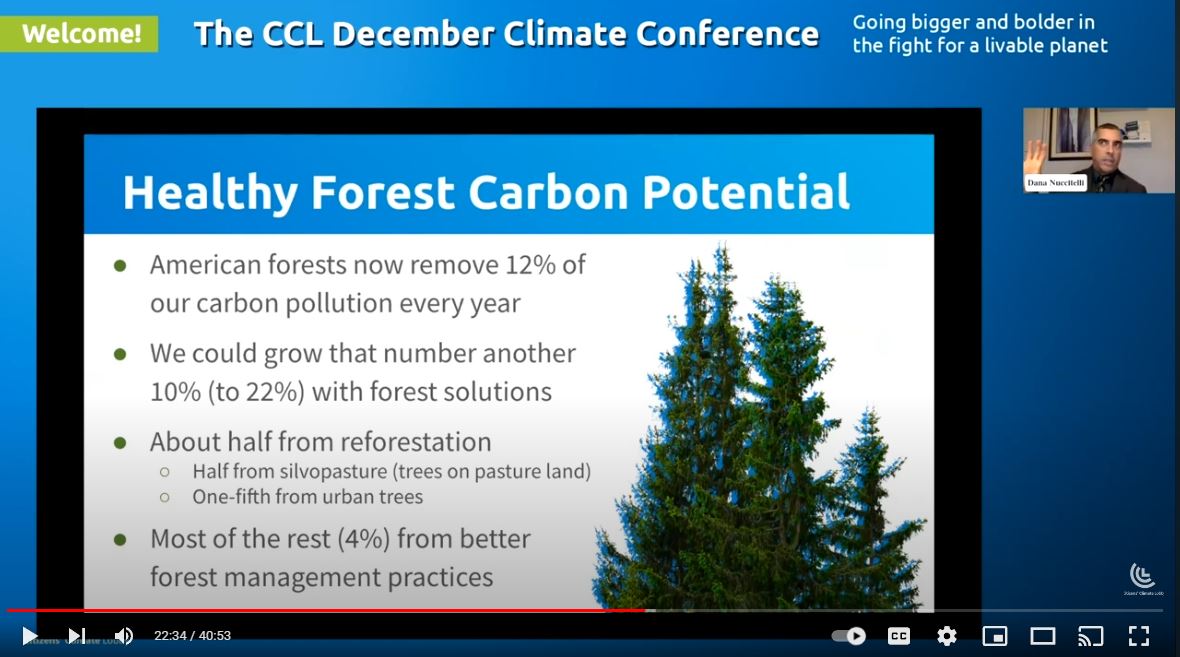 Rolling out CCL’s 2023 Policy Agenda at the December 2022 conference
Rolling out CCL’s 2023 Policy Agenda at the December 2022 conference